
Ruberoid is a roll of insulating material, which is often used in cases where it is necessary to cover a flat roof. This is one of the cheapest ways to protect against rainfall, but anyone who knows how to block the roof with roofing material will be able to quickly repair the old roof and not get into a difficult situation after the first rain begins. So if you are also interested in the question of overlapping a roof with a roofing material with your own hands, then our article will be very helpful: we will tell you useful tips on how to block a roof with a roofing material.
Content
Features of roofing material
Ruberoid is a reliable durable and practical option that can be used for both residential and utility buildings. Despite the simplicity of the installation technology of this material, you will need several experienced assistants who will allow you to complete the work quickly and with minimal problems. Below are the features of roofing material:
- Life time. It is at least 5 years, which at a relatively low cost makes this material very attractive for equipping roofs of farm buildings, and it can be used for residential buildings.
- Practicality. A properly made roofing from roofing material does not require any maintenance. Only at the end of the service life of the material will it need to be closed.
- Resistance to UV radiation. Modern materials have a special sprinkling of mineral chips, which provides increased resistance to UV radiation. They can also withstand both low and high temperatures.
The material is also not afraid of water, and when properly installed, it will become a reliable barrier to moisture. In the general case, roofing material is a multilayer sheet, the basis for which is special cardboard. On top of it, bitumen and other components are already applied. Due to the use of a cheap base, the cost of the finished product is also low, but those who do not know how to cover the roof with roofing material can make a number of mistakes that will lead to the fact that the cardboard layer is exposed. The base will begin to gain moisture, and the roofing material will swell and lose most of its properties.

The weight of the roofing material is relatively small, so a particularly powerful rafter system is not required, but you need to remember that there can be wind and snow loads, which should be taken into account when designing the base for the roof.
Roofing marking
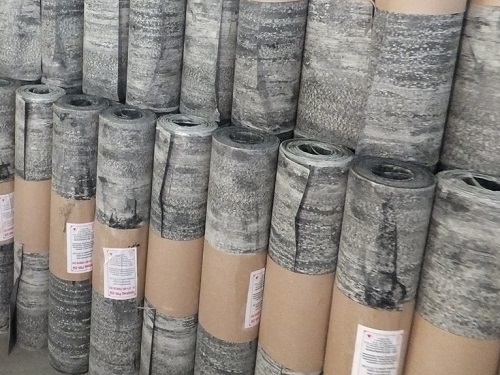
There are several types of such materials, and each of them is designed to solve a certain range of problems. To simplify the selection procedure, we will decipher the abbreviations used to denote this material.
The first letter is "P" - it speaks of the name of the material "roofing material". The second may be the letter "K", which says its purpose, and the density of the base shows the next figure after the letters. The density itself is indicated in grams per m2. The second “K” is the roofing, and “P” is the lining. In the general case, roofing material can be divided into 4 more groups. According to the type of topping, there are:
- “K” is coarse-grained;
- "P" is dusty;
- "M" - fine-grained;
- "H" is scaly.
The choice of any type of material depends on the type and shape of the roof, as well as on the expected impacts on it.Before you cover the roof with roofing material, you need to take care of the preparation of everything necessary for such work. First of all, you need to prepare the mastic.
Cooking bitumen mastic
Bituminous mastics come in 2 types - cold and hot. In order to get the first version of mastic you need to stock up with kerosene, bitumen and filler. Bitumen can be BN-90/10, and asbestos proved to be excellent as a filler.

Bitumen must be brought to a boil, and then kept in this state until then until the foam ceases to form. This is necessary to remove impurities.
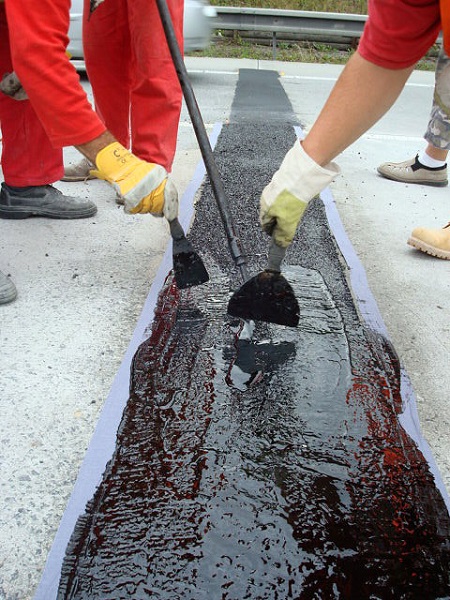
After cooling the mixture, a finished mass is obtained, which can be used to glue the rolled material to a concrete surface. At 20C, it is a homogeneous mass, which has a semi-liquid consistency and has a characteristic odor of solvent.
Hot mastic can also be cooked in a bucket, but in this case it will constantly “burn”, therefore it is better to stock up with a thick-walled boiler, which will also have a lid.

After the bitumen is freed from packaging, you need to try to avoid getting foreign impurities and various debris on it, so the lid on the boiler will come in handy.
Those who are asking for the first time the question “how to cover the roof with roofing material?” Should perform the following operations to prepare the mastic:
- The boiler is filled with pieces of bitumen for 2/3 of the volume, after which you can start heating. The process should go evenly, which means that the composition cannot be overheated and it is better to use a slow fire. When the contents of the boiler turn into a homogeneous mass, care must be taken to remove impurities that appear on the surface.

Foam can be removed using a conventional tin can, which should be nailed to the cutting board or timber. This will allow you to clean the surface of the mixture with minimal risk to the skin.
- The temperature in the boiler can range from 150 to 200 ° C, so the preparation time of the mastic will vary from 3 hours to an hour. It is not recommended to increase the temperature, since with a higher value, the quality of the mastic can significantly decrease, and with a further increase, ignition will begin.
- Filler is introduced into the heated bitumen. Peat crumbs, fine sawdust, flour, various varieties of asbestos or ground chalk can claim this role. Any of these substances must first be dried and passed through a sieve.

To get 10 kilograms of bitumen mastic, you will need to use the ratio of bitumen and filler 8 to 2.
- Bitumen is heated until the foam stops rising, after which filler is introduced. In the process of adding powder, you need to mix the composition.
- At the next stage, the used oil is poured into the mixture, which is also desirable to prepare in sufficient quantities. Simultaneously with the application of oil, the contents of the boiler must be mixed.
Oil application is the final stage in the preparation of hot mastic. Obviously, such a mastic needs to be prepared right before covering the roof with roofing material, since it retains its properties only in the hot state.
It should also be noted that increasing the temperature and igniting the mixture in the boiler will lead to the fact that the mastic itself will not be used. In the event of a fire, it is necessary to cover the boiler with a lid or a metal sheet, however, even an extinct mixture should not be used.

You can avoid ignition by paying a little attention to the surface of bitumen. If the temperature is normal, then gray smoke comes from the boiler, and the mixture hisses slightly. If you observe bubbles and yellow smoke, the coking process is already underway and the temperature needs to be urgently reduced.
We cover the gable roof with roofing material
In order to fix the roofing material on the rafter roof, you will need to use a continuous crate, which will avoid the appearance of gaps or sagging.This design can be made of durable plywood or boards, and only then proceed with the installation of roofing felt. This work is best done together, since you will need to unwind the roll around the crate and at the same time hold the rest of it.

If the work is done alone, it makes sense to make a Z-shaped holder for the roll from a thick steel bar, which will allow you to perform this work without any additional help.
The ruberoid is laid in layers, however, the last 2 run can cause some difficulties, since it will be necessary to lay it from the outside. To do this, use the stairs. Obviously, if you think not about how to cover the roof with roofing material, but about economy, then nothing good will come of it. Before starting work, it is necessary to develop a suitable installation option for the crate and a method for laying roll material.
Features of the installation of roofing material
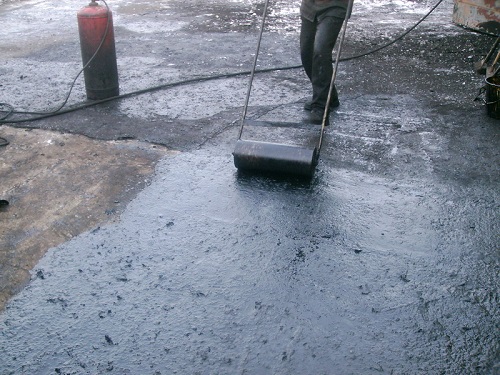
The first rule that you need to learn when working with this material is that you need to lay it on a clean foundation. For example, if there are various contaminants, dust or moss, they must be removed. Of course, in each case, the problems can be different, therefore, it does not hurt to seek the advice of a specialist who can not only prompt, but also help with complex calculations.
The minimum number of layers for any type of roof is two, and the lower of them should be laid with the litter type material, and roofing material with topping is placed on top of it. Today, euroroofing material is of most interest.

The film used to protect the bottom layer is also an indicator of temperature, so when it turns white and burns out, you can start laying the euroroofing material. It is better not to overheat the sheets themselves, since they can lose their characteristics or completely melt.
The installation technology of euroroofing material consists of several stages, in the first of which you need to prepare the base. Typically, the coating is coated with mastic and then warmed up with a gas burner. Then comes the turn of roofing material, which they try to evenly distribute on the roof surface so that there are no distortions. The next step is material leveling, performed using a special roller.
Of course, you can do without this procedure, but air will remain under the roofing material layer. Such caverns will be a place of condensate formation, which means that the site will gradually become unusable and will require repair. Usually, all the subtle moments are thought out before covering the roof with roofing material.
Properly laid web material does not have any air defects.

To eliminate pockets where air is contained, you can use rags collected in a roll, which you can tap on the roofing material, attaching it to the base of the roof. If the fit of the material is insufficient, you need to use a wooden rail.
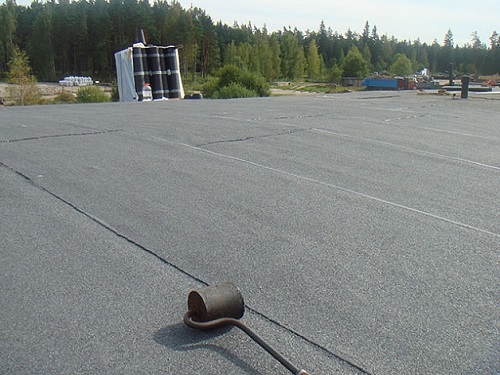
Sometimes a reinforcing mesh is laid on the mastic. This step is not always used, but it is attractive in that during gluing the roll material will not slip, and the fit to the base will be more dense.
All work is best done in dry weather at a positive temperature. In frost, roofing material can be easily damaged, so its installation is most often performed in the warm season. To simplify the work, it is better to cut the material into fragments of the desired length in advance. Partitioning is best done with a margin, since the edges should be tucked under the base of the roof. Stock is usually selected at least 20 cm.
How to repair a roof from roofing material
If any violations were made in the installation technology, then various defects can occur on the roof itself, which will not be so easy to eliminate, however, a correctly executed coating requires timely repair.
Maintenance is much cheaper than capital repairs, and much faster.First you need to determine the location of the damage, after which the gravel sprinkle is swept away with a dry brush. In this situation, it is advisable to use a building hair dryer, which will deal much faster with natural pollution in the form of moss and remove other solid particles, as well as dirt.
A cross-shaped incision is made in the center of the marked zone, and the base area under the roofing material is thoroughly cleaned and dried. Then, heated mastic is applied here, after which the edges of the cut are pressed. To align in this situation, you can use the roller to roll wallpaper.
If the edges do not converge, then it is worth using a reinforcing polyester pad or waterproofing tape. If work is carried out at high humidity, you can use a waterproofing tape, the use of which is described on the package.
The tips given in this article can help even a novice builder to prevent stupid mistakes, the price of which can be an early overhaul of the roof. We talked in detail about how to properly cover the roof with roofing material, and even described the process of making mastic. Here, only the technology of creating the crate was omitted, since it has already been repeatedly described in our other articles.

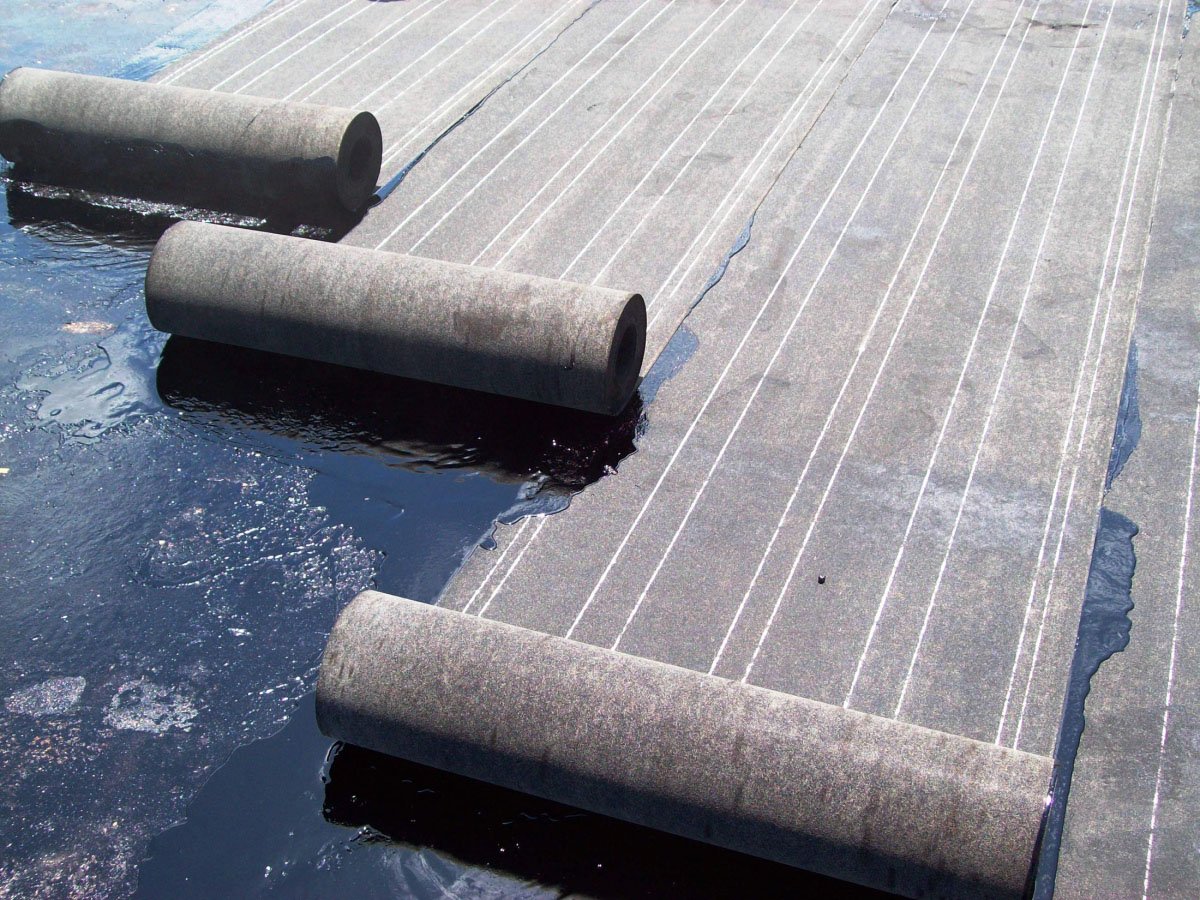



Alas, no comments yet. Be the first!